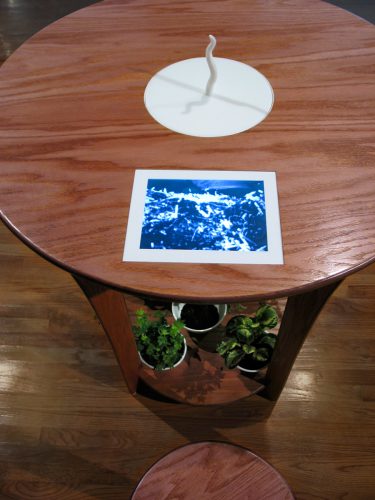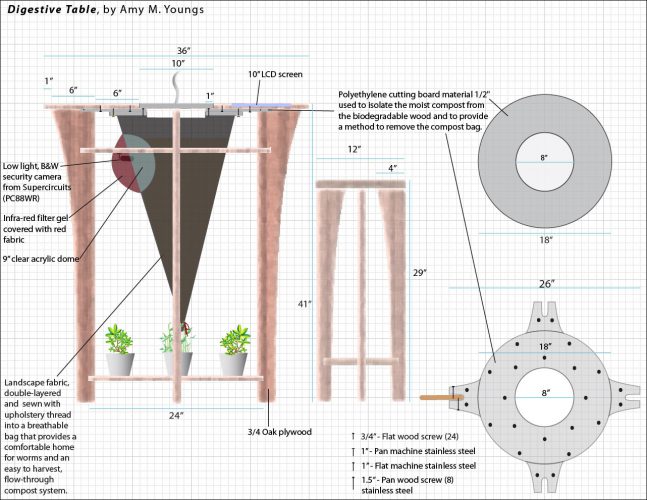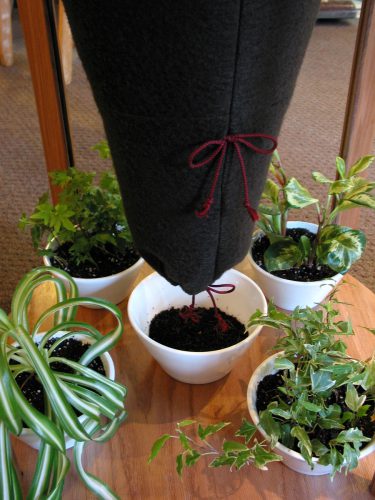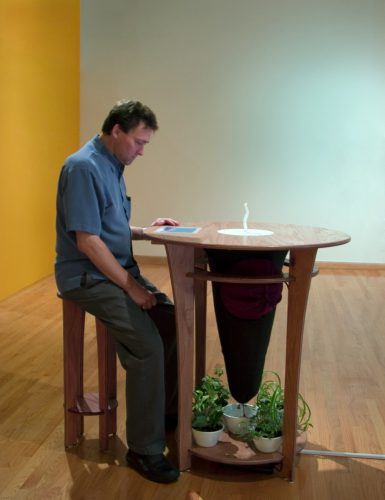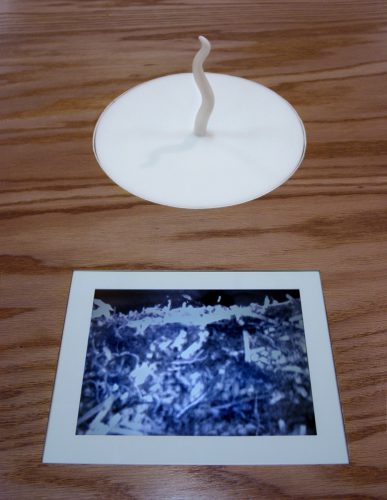A living ecosystem of worms, sowbugs and bacteria are invited to this table. They are a part of the digestive system that starts with a person discarding food leftovers and shredded paper into the portal at the top. The bacteria and sowbugs begin breaking down the waste and the worms soon join in to further digest it into a rich compost that sprinkles out of the bottom of the fabric bag that hangs beneath the table. This compost is used as a fertilizer for plants, such as those at the base of the table.
The human plays an important part at the table by eating, feeding the food waste to the worms, feeding the resulting fertilizer to the plants, or by simply sitting and appreciating the living ecosystem she/he is a part of. A cross-section of the activity inside the top 9 inches of the compost is made visible using an infrared security camera connected to an LCD screen built into the table. On the screen, viewers can see the live movements of the worms and sowbugs inside.
Technical info
Vermicomposting – The hand-made composting bag is based on a “flow-through” vermicomposting system, designed to make harvesting the worm castings much easier. Standard methods involve separating worms by hand, or by lifting heavy sections of the stacking tray type of bin. I use several types of bins at home, including the homemade plastic tub type and the fancy, stacking tray type, but I am most excited about the ease of use of this new bag type. To construct my own vermicomposting bag, I’ve sewn together 2 layers of landscape fabric, rather than use plastic, in order to increase the air circulation around the sides, but the top is closed off, to keep more moisture up there. The worms like the moisture level to be around 75 – 85%. To harvest the “black gold” castings, I simply untie the string at the bottom of the bag and squeeze it a bit to allow the finished castings to fall out. Very few worms remain at the bottom of the bag where the finished castings are, because the food is at the top of the bag and the material gets a bit drier at the base, so the worms don’t like it. If you’d like to build a your own basic flow-through worm bag, I’ve made an Instructable for you here.
Seeing worms – is more difficult than you might imagine, since worms are harmed by white light. They do not mind infra-red, but humans cannot see in that frequency. Video cameras are sensitive to that frequency, but often have filters to remove it. The video camera used in this project is a very low light, black and white security camera (.0003 lux, 600 lines of resolution, Sony Super HAD CCD). It is showing the worms and sowbugs live, using infra-red light that filters in from the theater gels located beneath the feeding portal (because it turns out the white polyethylene lets a little light in) and on the side of the bag where a clear acrylic dome cuts into the fabric for the camera to image the action inside the composting material. The filters that allow only infra-red to pass are Rosco #27 and #382, discussed in detail here. The camera is connected to a 10″ LCD screen, which was removed from a $200 snail-shaped TV for kids made by Hannspree.
Wood and stain – The wood is FSC (Forest Stewardship Council Certified) oak plywood, which I actually purchased at Lowes. They have a policy to “agressively phase out the purchase of wood products from endangered forests”. In an effort to be ecological – and to reference the cycle of food reprocessing – I decided to stain the wood with a homemade concoction of boiled red cabbage, mixed with a little worm compost tea (leachate from pure worm castings) and alum. This stain is beautifully purple at first, but after a few days the color fades quite a lot, even after 2 coats of polyurethane…
Inspirations
Dr. Clive Edwards and Norman Aroncon, soil ecology researchers at the Ohio State University who graciously showed me their vermicomposting research and answered my many questions. Their recent research paper is, Effects of Vermicompost Tea on Plant Growth and Disease. The Earth Moved: On the Remarkable Achievements of Earthworms – a book by Amy Stewart. Soil Factory, by N55, eco concept art/design collective in Copenhagen, Denmark. MASSIVE CHANGE, Bruce Mau Design and the Institute Without Boundaries
